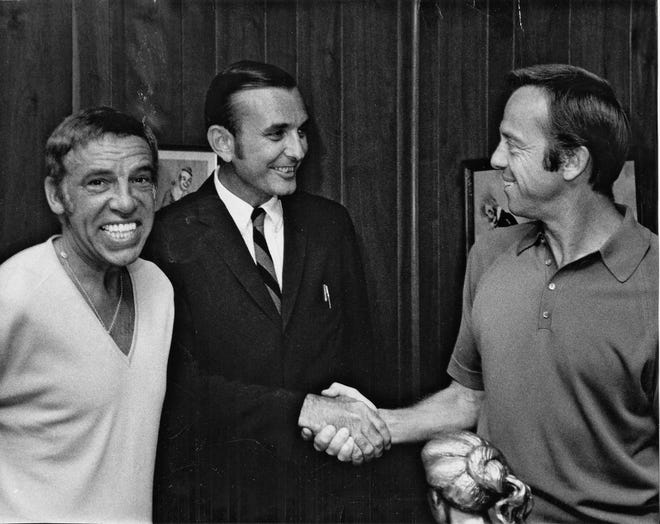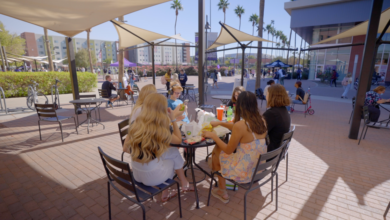
'Breaking new ground': Gap is launching its first home line through Walmart
- Hi everyone. I'm Monique Valeris, the Senior Home Editor at Good Housekeeping. Thanks so much for joining us and thanks to Pergo for sponsoring our conversation on design trends. I'm so excited to have three awesome design experts with me Stacey-Ann Blake, Young Huh, and Nicole Gibbons. So let me begin by having you introduce yourself to our audience. Stacey, I'll start with you. - Hi, I'm Stacey of Design Addict Mom, I'm known online as the Lover of Color, and fearless person who embraces color in her designs. I have three children. When I'm not designing, I'm busy being mom. - I'm a mom too, so I'm excited to hear that. Young, tell us a bit about yourself before we start chatting. - So, my name is Young Huh, I'm an interior designer in New York. We do projects across the country and around the world. Our work spans from hospitality projects to residential projects. We are known for use of color, for using pattern on pattern, and bringing sort of a classical feel to really modern interiors. - Excellent. And Nicole, tell us a bit about yourself. - Hi, I'm Nicole Gibbons. I am also an interior designer. I started out, though, as a design blogger, then pivoted into becoming a full-time interior designer, working with private clients in and around New York City. And now I've sort of pivoted again, still a designer at heart, but I'm now I'm the founder and CEO of a direct to consumer paint startup called Clare. And we make the whole process of buying paint for your home super easy. - That's so great change is good, so I'm all for it Nicole. Let's jump in. So, you know, design trends can be really hard to navigate as a design editor, it's something that I'm always paying attention to. It informs our editorial content, both for the magazine and our website. But I think for the average design enthusiasts it can be really overwhelming to figure out how to make these trends your own. So what do you all recommend? Young, I'll start with you. Any advice on how to navigate design trends? - I think for me, if there's a trend best to try to avoid it because that means you're going to be falling in with a million other people and then your house might look like everyone else's. Like modern farmhouse, cottagecore, those two things like, make me a little concerned because, you know, that means it's become, this design trend has become canned. However, there's certain things about it that are really great. I love the idea of taking an old farm house and bringing it to the modern age, adding modern elements to something that's really old and classic. It's a way of cherishing our history. Cottagecore for instance, I adore cottages, anything romantic, pretty, sweet, I am all over it. But do you really want to be sort of in that niche, you know, maybe think of ways that you could bring your own personality to any design trend and make it yours. - That's great advice. How about you, Stacey? What do you recommend as far as experimenting with design trends and not feeling intimidated by them? - Yes. I'm probably going to echo a bit of what Young said, about avoiding trends. I avoid trends. I always recommend when you design that you embrace who you are. I think your space should, you might end up incorporating some trend or trends but that's because that's what you like. Your home should be an expression of you. So if you like Chevrons, because I know chevrons are under that category of being antiquated right now, but if you like chevrons by all means, embrace them. So again, if you, basically whatever you like in your home, whatever your taste is, that's what you should embrace and how you should decorate. - And I know Nicole, you agree a lot. You know, your design philosophy is all about making sure that your home reflects your personal style. So what's your take on trends and really making it feel more accessible to you? - Yeah, I definitely echo all of the same things that Young and Stacey said. I think your home should absolutely reflect who you are. And when you think about it just from a practical standpoint, your home is the biggest, one of the biggest investments you'll ever make. And so, especially as it relates to the more permanent decisions, things like tile and flooring and your furniture, the things, the big ticket items, and even some of your foundational elements, like your paint color, that you're probably not gonna want to change up every six months, you know, you want to choose things that you can live with for a very long time. And so I'm a big fan of timeless over trendy. However, I do think that there are certain areas where it is okay to experiment. And it just depends on, how the type of person you are. If you are the type of person that does like to change up your home a lot or do little seasonal decor swaps, I think that's when it's okay to maybe lean into something that's popular. So if there's a certain color and you want to refresh your tabletop for spring maybe you get the millennial pink plates. But I think when it comes to the real kind of permanent decisions and the foundation of your home I'd say keep it timeless because I can ensure you'll love it for a lot longer than you will whatever is the trend of the moment. - That's great. Those small upgrades that feels manageable to me. I think that's great advice. - You spend 30 bucks on a trendy vase, and you don't like it six months later, it's less of a loss or a, you know, kind of a money pit. then, you know, if you designed your entire home because you fell in love with the cottagecore trend. - So, so true. It's so true. So the pandemic is not over but we're close to being on the other side, fingers crossed. How has the concept of home changed for people? I mean, there's been a lot of talk about these multipurpose rooms that do triple duty. I mean, for me, I mean our living room functions in so many different ways, I've exercised in here, my daughter tackles school in here, we watch movies in here. It does so much for us. So just talk about what you've noticed considering the pandemic. Young, I'd love to hear your thoughts there. - Yeah, I think that for the first time families are really spending a lot of time together and you know using homes for work school, play, entertainment, exercise, we've all been exercising at home, not going to gyms. So, homes have had to be really multi-use, multifunctional, and yeah, I do yoga in my living room. And then I time it so no one's there, when I'm doing that. - Nothing wrong with that, Young, at all. - So, you know, we all, I think are changing in the ways that we think of our homes. People used to eat out all the time. We used to look outside for entertainment and now that's not happening as much. So homes are now just not one use. You might bring in a game table into your living room. You might make sure there's extra floor space where you might've had a chair. You might need desks in every bedroom, that's like a new one. I think in this time period, everyone has been like, I need a Zoom corner. How do I do that in my bedroom, so I can shut the door and I don't hear other Zooms going on. All of these-- - You've nailed that, by the way, Young, I have to say. Your Zooming corner is a plus for me. - This is my zoom corner in my office. - It's awesome. - Thank you. Those are all things that we now have to consider. And you know, a lot of adult children are coming back home to live with their families, like mine. And so they have work. They have school. How do you all fit together, and make it livable and harmonious? - Yeah. It's a lot to consider. Stacey, I'm curious to hear what you think about how, you know, the concept of home has changed for people considering the pandemic and everything that's going on right now. - Yes, as Young spoke I was smiling a lot, because if I were to move my camera to my left, I'm sitting at the Dorma of my, well, it might be antiquated to refer to it as the man-cave, but that is what it is. However, this is where I teach from and work. But in addition to that, I also have a three-year-old. Basically, I'm a prime example of re-imagining your spaces and navigating the pandemic. To the left of me, I have what you would probably categorize as a daycare because my daughter, she comes into the space but, in order to distract her, I have one of those mini trampolines. I also have a slide for her. - Wow, design for your daughter for your home, Stacey. Wow. Perfect setup. - Yes. So, to answer that question we've had to reimagine our spaces and how we live, and we all have to function within that space. So I had to figure out a way that I could teach and also be a mother. And that is what many people have had to do because they were stuck and still are at home. So reimagining your spaces, getting creative, thinking outside of the box to navigate this pandemic. - That's interesting. And Nicole, I mean, from your experience, have you found that people are focusing on one room in their home or are they kind of trying to spruce up everything at one time? What have you noticed? - Yeah, I mean, I definitely think people are tackling their whole homes. You know, the average DIYer is doing it little by little and, you know, Stacey and Young, touched on how our homes are serving all of these multi-functions these days. But I think like for the average person, you know, all of us on this call, are probably the exceptions, because we all work in design and live and breathe it. And so we're constantly thinking about how our homes should look and function. But I think for the average person who's busy with their lives and their children and their jobs, they're not thinking about those things, but the pandemic forced them to, it forced them to evaluate how they feel in their home, how content or not they are with their homes' decor, and, you know, really understanding how important it is have a home that makes you feel good when you walk through the door. So I think what we're seeing, especially at Clare, you know we work with them, we have a wide variety of customers, we serve the masses. And so people are looking around at their white walls that they never bothered to paint and being like I really need to change this color because I'm so tired of white walls and I want to feel invigorated or I want to feel calm. You know, it's been a hectic year. I think people are kind of room by room tackling those paint projects and turning their houses into homes that they love, and I think the pandemic really made everyone reevaluate just the overall role that home plays in our lives. And, you know, I think even after the pandemic is over, hopefully that will be soon, I still think people are gonna take a while to kind of assimilate back into the real world as it used to be. And so I still, I believe we're still going to see people doing a lot more entertaining at home you know, kind of, and wanting their home to reflect who they are so that when they do hosts and gather and start to kind of invite people back in again they're really proud of the space that they have and that it's conducive to, you know, kind of that new lifestyle that centered around the home. - That's so true. Decorating and renovating it's a never ending project. So I wanna switch gears a bit. You know, flooring really sets the foundation for your home, the Pergo Extreme collection, it has great flooring solutions that look like authentic wood or tile, but they're much more durable for high traffic areas of the home, like kitchens, playrooms, pool houses, I wanna open up this question to the entire panel. Where would you suggest using luxury vinyl flooring instead of real wood or tile? You know, they're ideal for these high traffic areas, as I mentioned. So I'm curious to hear your take. Stacey, let's start with you. - I love that those kinds of floorings are very durable and tend to be waterproof. The laundry room typically may not be a high traffic area but I think that would be a great space, even a basement that is possibly serving as a media space. I think that would be a great place to, for, you know those luxury type flooring but more on the affordable option. - Great ideas. How about you, Young, what's your take on luxury vinyl flooring and where, where does it work best? - We have projects where, especially in a ski house, when you're coming in with your boots and equipment, you know, tile will crack and wood will, you know, pit. So you have to use synthetic flooring, so vinyl is a really good option areas where you're doing sports, for sure need vinyl flooring. And, you know, it had been in the past hard to find things that looked really luxurious. So the trends that we're seeing there, things that are stone look, wood look more, even, you know, off the charts like blue wacky patterns, you know, it could be just about anything but there's definitely a use for luxury vinyl because it's a necessity. - I agree, Nicole, any thoughts on luxury vinyl flooring? - Yeah. I mean I think in addition to just the practical applications in spaces that like get a lot of traffic and moisture and whatever, I think it's also a good budget friendly alternative to hardwoods. If you are, you know, constrained and you still want to get that look, it's a really nice way to bring in the look of wood flooring, with an easier labor install, as well as like, probably a little lower overall costs. So it's a good budget friendly option for someone who you know, maybe doesn't have the budget for something else. - I agree. And we can't talk about trends without considering sustainability. I think it's fair to say that people are really being more thoughtful about what they're bringing into their home. As far as some of the sustainable home design trends that you know are popping up right now, What can you share, Stacey? I'm curious to hear your thoughts there. - I tend to gravitate towards natural made pieces, I'm now, I am finding I've always loved wooden pieces, but especially now natural pieces that embrace nature and bring a bit of that in. I think that's great. People since they've been at home, they're concerned with what they're breathing in, the toxicity in materials. And I think they have actually taken a conscious effort to choose eco-friendly pieces to create that space that is green eco-friendly and healthy. - I agree. And I feel like that plays into global inspired interiors. You know, we're seeing a lot of reten pieces right now. Nicole, any thoughts on global design in general? I know you love to mix and match and, you know pair modern with vintage. So I'm just curious to hear your take there. - Yeah, I mean, I love global design. I love pattern, I love ethnic inspired in patterns. I'm a big fan of, you know, the teeth prints and, you know eat cats and all of those like amazing things. And they're so rich in color and I think that's why I'm drawn to them, generally. So I think like, you know, mixing up those elements in your home makes it so much more interesting and layering in those sort of global pieces can really lend more personality to your space. - I agree. And Young, any thoughts on global design? I mean, people are eager to get back on planes. You know, they're really thinking about how to weave some of those cultural influences into their space. So what's your take there? - I think global design has always been with us. At the moment people traveled they wanted to bring things that were beautiful and amazing that they saw on their travels. You know, the silk road, you saw a mix of Arabic, Chinese, Roman, cultures mixing together, and you've got these fantastic patterns, fantastic artworks. And the more we can mix and collide and borrow from each other, the more rich culture will be more rich, our interior decorative arts will be. And I think people really love, as you say, traveling and bringing these things back, it shows a kind of understanding, openness and the layering and richness in your design. So, I think that's very important going forward. - Excellent. Okay, so we're winding down and I have a loaded question for you guys. I want to hear the one design trend that you really want to go away. And one trend that we can expect to see in the year ahead. So Stacey, let's start with you. I can't wait to hear your response. - I might be biased, but goodness, I just want more color. - Yeah. - More color please. - I understand. - And I do have white walls in my home. This is not about banning white walls, at all, but I would just love to see a little bit more vibrancy. I know people are hesitant and tend to be hesitant when it comes to embracing color, but it could just be in your accessories. You could start there, start small, but color. And being at home, I'm sure people have realized that the impact, the existence of color has on one's mood. Behind me, this was a conscious effort to add some joy in this small space of mine. So don't be afraid of color at all. I want more color. - Yeah, it changes the feel of a room, you're so right about that. Nicole, one trend that you really just can't stand right now, and one that you think we'll see more of next year. - Yeah, I mean, honestly, Stacey took all the words out of my mouth because that's the first thing that came to mind even before she gave her answer. You know, I think that there is this look that I think is lovely, and it's that California casual, all white, you know, you guys are, y'all all know the look, right. Popularized by a handful of really big influencers on Instagram and just overall it's I think it's kind of a preferred aesthetic in California. And I think it's a really beautiful look, but I am kind of tired of seeing that, and I would love to see more color. And it's not, it's not about the decor, but it's just, you could, so many of those spaces that I see that, that have that California vibe, with all white walls would look so much more stunning with bold color. And, you know, I think color, while it can be trendy is sort of timeless. It's almost like, you know it's the color that speaks to you, the color that creates the mood that you want to feel. So like, for example, it's not that white isn't passe trend but it's just this idea that people are and have embraced this, like all white look that at times when especially when not done well and not layered well, just feel sterile and void of personality, so I would love to see people embrace more color as well and yeah. - I completely agree. Young, I'm so curious to hear about the one trend that you want to disappear and one that you think we can expect to see more of in the year ahead. - So, I hate to hate on design trends but I am going to share this one with you. - Please do. - It really bothers me how we're seeing a lot of these new McMansions that are kind of modern farmhouse, they're white, they have black metal doors, they have metal roofs. They all look the same. And I think, you know, it's, they're building a lot of them upstate where a lot of homes are older and instead of refurbishing what's existing, and I know it takes a lot of effort to add modern amenities to an old house, but I just feel like these houses are gonna be like the houses from the eighties that no one wants today. You know, it's like, it becomes this canned mock, you know, mass product. And, you know, I think there could be a way to build a house like that, they can be really, really attractive once you add personality to it, you know, just changing a little bit, being maybe thoughtful about the windows, maybe adding some molding detail. So yeah, I predict that that's to be like ah, the trend that you hate soon. - Great, I agree. So, you know, any final thoughts as we wrap up, as people are considering trends, and trying to pinpoint exactly what to incorporate into their spaces. Stacey final thoughts before we close. - I think I started with these thoughts and I'm going to end with the same thing. Be yourself. Your home should be an expression of who you are. Not necessarily, an exhibition of trends, express yourself. - I love that. How about you, Nicole, last words for our audience? - Yeah, I think create a home that makes you happy, a home that you'll love every single time you're in any room in your home. You know, so many people will just have their space be good enough, and then boom, there's a pandemic. And you realize how much you just dislike, so really invest in creating a home you love, and embrace color. - Love that. Young, last thoughts on embracing design trends. - Don't fill your rooms with too many Instagram ideas. You know. - So true. - It will be tragic. - I totally agree. - Choose who you are and be true to it. - I love that. Well thank you for joining us, you know, thanks to our panelists. You all had some great ideas that I'm personally going to incorporate into my own home. And thanks to our sponsor Pergo who will now be hosting a breakout session where you can talk directly to Pergo's experts in luxury flooring, to get inspiration, and answers to all of your burning flooring questions. All you have to do is click the link below your screen to join now. Thank you so much for watching.
Related video above: The Makeover Takeover Renovation Summit discusses home design trends for 2021Gap and Walmart have teamed up to launch Gap Home, a Gap-branded home decor, bedding, tabletop and bath collection set to debut next month.The collection of more than 400 items, including products made with organic cotton and recycled materials, will be sold exclusively on Walmart.com beginning June 24.Gap has been trying to turn itself around under its CEO Sonia Syngal, who took over last year and has focused on reviving Gap's namesake brand. Part of that effort involves expanding into new areas for sales growth.Last May, Gap announced a deal with global licensing company IMG to help expand its brand beyond apparel to other categories such as home decor, baby equipment and furniture as a way to grow its market and attract new customers.Gap Brand CEO Mark Breitbard said Gap Home was the "first foray" into those new areas. "It's breaking new ground for us. We want to learn fast and think big," Breitbard said during an interview with CNNBusiness.He said Gap Home will be a multiyear partnership with Walmart, the largest retailer in the United States. "When you look at the scale that Walmart has, a key part of this is that it's a way to bring new customers to the Gap brand. So scaling through Walmart, which already has expertise in home, is a slam dunk."The collection features items like a pillow made from light chambray material for $16 and a King size reversible comforter set made from soft jersey material for $65.For Walmart, the deal allows it to become more competitive in the home category through exclusive offerings at accessible prices, said Anthony Soohoo, executive vice president of Walmart's home division.It's not the only one expanding in the category through partnerships. In late February, Target launched a limited-edition exclusive collection of home decor and pet accessories with denim brand Levi's."Home has been an area where the customer has spent more time ," Soohoo told CNNBusiness. "As we get out of the pandemic, we have a new appreciation for home."
Related video above: The Makeover Takeover Renovation Summit discusses home design trends for 2021
Gap and Walmart have teamed up to launch Gap Home, a Gap-branded home decor, bedding, tabletop and bath collection set to debut next month.
The collection of more than 400 items, including products made with organic cotton and recycled materials, will be sold exclusively on Walmart.com beginning June 24.
Gap has been trying to turn itself around under its CEO Sonia Syngal, who took over last year and has focused on reviving Gap's namesake brand. Part of that effort involves expanding into new areas for sales growth.
Last May, Gap announced a deal with global licensing company IMG to help expand its brand beyond apparel to other categories such as home decor, baby equipment and furniture as a way to grow its market and attract new customers.
Gap Brand CEO Mark Breitbard said Gap Home was the "first foray" into those new areas. "It's breaking new ground for us. We want to learn fast and think big," Breitbard said during an interview with CNNBusiness.
He said Gap Home will be a multiyear partnership with Walmart, the largest retailer in the United States. "When you look at the scale that Walmart has, a key part of this [deal] is that it's a way to bring new customers to the Gap brand. So scaling through Walmart, which already has expertise in home, is a slam dunk."
The collection features items like a pillow made from light chambray material for $16 and a King size reversible comforter set made from soft jersey material for $65.
For Walmart, the deal allows it to become more competitive in the home category through exclusive offerings at accessible prices, said Anthony Soohoo, executive vice president of Walmart's home division.
It's not the only one expanding in the category through partnerships. In late February, Target launched a limited-edition exclusive collection of home decor and pet accessories with denim brand Levi's.
"Home has been an area where the customer has spent more time [in the last year]," Soohoo told CNNBusiness. "As we get out of the pandemic, we have a new appreciation for home."
Source link











